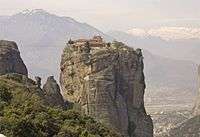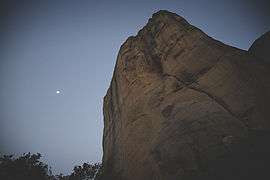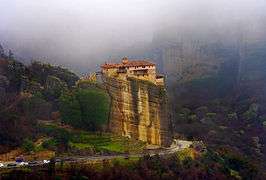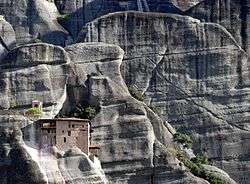Meteora
| Metéora | |
|---|---|
|
Native name Greek: Μετέωρα | |
|
Monastery of St. Nicholas Anapausas | |
| Location | Thessaly, Greece |
| Coordinates | 39°42′51″N 21°37′52″E / 39.71417°N 21.63111°ECoordinates: 39°42′51″N 21°37′52″E / 39.71417°N 21.63111°E |
| Official name: Metéora | |
| Type | Cultural |
| Criteria | i, ii, iv, v, vii |
| Designated | 1988 (12th session) |
| Reference no. | 455 |
| State Party | Greece |
| Region | Europe and North America |
 Location in Greece | |
The Metéora (Greek: Μετέωρα, pronounced [mɛˈtɛoɾɐ], literally "middle of the sky", "suspended in the air" or "in the heavens above" — etymologically related to meteorology) - is a formation of immense monolithic pillars and hills like huge rounded boulders which dominate the local area.
It is also associated with one of the largest and most precipitously built complexes of Eastern Orthodox monasteries in Greece, second in importance only to Mount Athos.[1] The six monasteries are built on natural conglomerate pillars, at the northwestern edge of the Plain of Thessaly near the Pineios river and Pindus Mountains, in central Greece.
Metéora is included on the UNESCO World Heritage List under criteria[2] I, II, IV, V and VII.[3]
The nearest town is Kalambaka.
Geology
Beside the Pindos Mountains, in the western region of Thessaly, these unique and enormous columns of rock rise precipitously from the ground. But their unusual form is not easy to explain geologically. They are not volcanic plugs of hard igneous rock typical elsewhere, but the rocks are composed of a mixture of sandstone and conglomerate.
The conglomerate was formed of deposits of stone, sand and mud from streams flowing into a delta at the edge of a lake, over millions of years. About 60 million years ago during the Paleogene Period [4] a series of earth movements pushed the seabed upwards, creating a high plateau and causing many vertical fault lines in the thick layer of sandstone. The huge rock pillars were then formed by weathering by water, wind and extremes of temperature on the vertical faults. It is unusual that this conglomerate formation and type of weathering are confined to a relatively localised area within the surrounding mountain formation.
This type of rock formation and weathering process has happened in many other places locally and throughout the world, but what makes Meteora's appearance special is firstly the uniformity of the sedimentary rock constituents deposited over millions of years leaving few signs of vertical layering, and secondly the localised abrupt vertical weathering.
History
Ancient History
Caves in the vicinity of Metéora were inhabited continuously between 50,000 and 5,000 years ago. The oldest known example of a man-made structure, a stone wall that blocked two-thirds of the entrance to the Theopetra Cave, was constructed 23,000 years ago, probably as a barrier against cold winds – the Earth was experiencing an ice age at the time – and many Paleolithic and Neolithic artifacts have been found within the caves.[5][6]
As early as the 11th century, monks occupied the caverns of Meteora. However, monasteries were not built until the 14th century, when the monks sought somewhere to hide in the face of an increasing number of Turkish attacks on Greece. At this time, access to the top was via removable ladders or windlass. Nowadays, getting up is a lot simpler due to steps being carved into the rock during the 1920’s. Of the 24 monasteries, only 6 (five male, one female) are still functioning, with each housing less than 10 individuals.[7]
The cave of Theopetra is located 4 kilometres (2.5 mi) from Kalambaka. Its uniqueness from an archeological perspective is that in it contains, within a single site, the records of two greatly significant cultural transitions: The replacement of Neanderthals by modern humans, and the later transition from hunter-gathering to farming after the end of the last Ice Age. The cave consists of an immense 500 square metres (5,400 sq ft) rectangular chamber at the foot of a limestone hill, which rises to the northeast above the village of Theopetra, with an entrance 17 metres (56 ft) wide by 3 metres (9.8 ft) high. It lies at the foot of the Chasia mountain range, which forms the natural boundary between Thessaly and Macedonia prefectures, while the Lithaios River, a tributary of the Pineios River, flows in front of the cave. The small Lithaios River flowing literally on the doorsteps of the cave meant that cave dwellers had always easy access to fresh, clean water without the need to cover daily long distances to find it.[8] Excavations and research and have discovered petrified diatoms, which have contributed to understanding the Palaeo-climate and climate changes. Radiocarbon dating evidences human presence dating back 50,000 years.[5] The cave is open to the public.
Monasteries
In the 9th century AD, an ascetic group of hermit monks moved up to the ancient pinnacles; they were the first people to inhabit Metéora since the Neolithic Era. They lived in hollows and fissures in the rock towers, some as high as 1800 ft (550m) above the plain. This great height, combined with the sheerness of the cliff walls, kept away all but the most determined visitors. Initially, the hermits led a life of solitude, meeting only on Sundays and special days to worship and pray in a chapel built at the foot of a rock known as Dhoupiani.[1]
The exact date of the establishment of the monasteries is unknown. By the late 11th and early 12th centuries, a rudimentary monastic state had formed called the Skete of Stagoi and was centered around the still-standing church of Theotokos (mother of God).[1] By the end of the 12th century, an ascetic community had flocked to Metéora.
In 1344, Athanasios Koinovitis from Mount Athos brought a group of followers to Metéora. From 1356 to 1372, he founded the great Meteoron monastery on Broad Rock, which were perfect for the monks; they were safe from political upheaval and had complete control of the entry to the monastery. The only means of reaching it was by climbing a long ladder, which was drawn up whenever the monks felt threatened.
At the end of the 14th century, the Byzantine Empire's 800-year reign over northern Greece was being increasingly threatened by Turkish raiders who wanted control over the fertile plain of Thessaly. The hermit monks, seeking a retreat from the expanding Turkish occupation, found the inaccessible rock pillars of Meteora to be an ideal refuge. More than 20 monasteries were built, beginning in the 14th century.[1] Six remain today.
In 1517, Nectarios and Theophanes built the monastery of Varlaám, which was reputed to house the finger of St John and the shoulder blade of St Andrew.
Access to the monasteries was originally (and deliberately) difficult, requiring either long ladders lashed together or large nets used to haul up both goods and people. This required quite a leap of faith – the ropes were replaced, so the story goes, only "when the Lord let them break".[9] In the words of UNESCO, "The net in which intrepid pilgrims were hoisted up vertically alongside the 373 metres (1,224 ft) cliff where the Varlaam monastery dominates the valley symbolizes the fragility of a traditional way of life that is threatened with extinction."[10]
Until the 17th century, the primary means of conveying goods and people from these eyries was by means of baskets and ropes.[11]
In 1921, Queen Marie of Romania visited Meteora, becoming the first woman ever allowed to enter the Great Meteoron monastery.[12] In the 1920s there was an improvement in the arrangements. Steps were cut into the rock, making the complex accessible via a bridge from the nearby plateau. During World War II the site was bombed. Many art treasures were stolen.
Six of the monasteries remain today.[10] Of these six, four are inhabited by men, and two by women. The monasteries are now tourist attractions.
List of Monasteries
At their peak in the sixteenth century there were 24 monasteries at Metéora in Greece. They were created to serve monks and nuns following the teachings of the Eastern Orthodox Church. Much of the architecture of these buildings is Athonite[13] in origin. Today there are six still functioning, while the remainder are in largely in ruin. Most of these are perched on high cliffs, now accessible by staircases cut into the rock formations. Of the six functioning monasteries, the Holy Monastery of St. Stephen and the Holy Monastery of Roussanou are inhabited by nuns while the remainder are inhabited by monks. The total monastic population of the Metéora monasteries in 2015 was 66, comprising 15 monks in four monasteries and 41 nuns in two monasteries.
| Monastery | Photograph |
|---|---|
| The Monastery of Great Meteoron - This is the largest of the monasteries located at Metéora, though in 2015 there were only 3 monks in residence. It was erected in the mid-14th century and was the subject of restoration and embellishment projects in 1483 and 1552. One building serves as the main museum for tourists. The Katholikon (main church), consecrated in honour of the Transfiguration of Jesus was erected in the middle of the 14th century and 1387/88 and decorated in 1483 and 1552.[14] |  |
| The Monastery of Varlaam – The Monastery of Varlaam is the second largest monastery in the Metéora complex, and in 2015 had the largest number of monks (seven) of the male monasteries. It was built in 1541 and embellished in 1548. A church, dedicated to All Saints, is in the Athonite type (cross-in-square with dome and choirs), with spacious exonarthex (lite) is surrounded by a dome. It was built in 1541/42 and decorated in 1548, while the exonarthex was decorated in 1566. The old refectory is used as a museum while north of the church is the parekklesion of the Three Bishops, built in 1627 and decorated in 1637.[15] |  |
| The Monastery of Rousanou/St. Barbara[16] was founded in the middle of the 16th century and decorated in 1560. Today it is a flourishing nunnery with 13 nuns in residence in 2015. |  |
| The Monastery of St. Nicholas Anapausas, built in the 16th century, has a small church, decorated by the noted Cretan painter Theophanis Strelitzas, in 1527. There was one monk in residence in 2015. |  |
| The Monastery of St. Stephen has a small church built in the 16th century and decorated in 1545. This monastery rests on the plain rather than on a cliff. It was shelled by the Nazis during World War II who believed it was harboring insurgents and was abandoned. The monastery was given over to nuns in 1961 and they have reconstructed it into a flourishing nunnery, with 28 nuns in residence in 2015.[17] |  |
|
The Monastery of the Holy Trinity is on top of the cliffs. It was built in 1475 and was remodeled in 1684, 1689, 1692, 1741. There were four monks in residence in 2015. |
 |
Art, literature, music and film inspired by Meteora
- Meteora, a 2012 Greek film devoted entirely to a story set in the Monastery of the Holy Trinity, Meteora.
- The monastery of Holy Trinity was a filming location in the 1981 James Bond movie For Your Eyes Only[18]
- Scenes from Tintin and the Golden Fleece were also shot at the Meteora monasteries.
- Michina, the main setting of the movie Pokémon: Arceus and the Jewel of Life is based on Meteora.
- Meteora is the main location in the fiction book The Spook's Sacrifice, by Lancashire author Joseph Delaney
- The Holy Monastery of St. Nicholas Anapausas was an inspiration for St. Francis Folly in the computer game Tomb Raider and Tomb Raider: Anniversary.
- One of the surviving characters in Max Brooks's zombie apocalypse novel, "World War Z" finds refuge and peace of mind in the monasteries during and after the zombie war.
- The 2012 movie Metéora directed by Spiros Stathoulopoulos is set in the monasteries and scenery of Meteora
- Primary location and name of Volume 3 in the comic book series "Le Décalogue" by French author Frank Giroud.
- The Eyrie of Vale of the House of Arryn from Game of Thrones is based on Meteora
- The Call of Duty: Modern Warfare 3 DLC Map "Sanctuary" is set in the monasteries of the Meteora.
- The 2003 album by Linkin Park takes its name from the site.
- The monasteries were a filming location for the 1976 action movie Sky Riders [19] starring Susannah York, James Coburn and Robert Culp.
- Meteora is one of several Greek locations in the fiction book Time Stands Still by California author Stacy Froumis
- In The Young Indiana Jones Chronicles episode "Travels with Father", Indiana and his father visit Meteor.
Gallery
 Meteora in the early morning hours.
Meteora in the early morning hours.- The Rousanou, the Nikolaos and the Grand Meteora monasteries.
 The Rousanou monastery.
The Rousanou monastery. Panorama of the Meteora valley
Panorama of the Meteora valley Panoramic view at Meteora valley
Panoramic view at Meteora valley Panoramic view at monastery Varlaam
Panoramic view at monastery Varlaam Panoramic view at monastery Roussanou
Panoramic view at monastery Roussanou Panoramic view at monasteries Varlaam and Grand Metereon
Panoramic view at monasteries Varlaam and Grand Metereon
Notes
- 1 2 3 4 Sofianos, D.Z.: "Metéora". Holy Monastery of Great Meteoro, 1991.
- ↑ retrieved November 7, 2007
- ↑ retrieved November 2, 2007
- ↑
- 1 2 Y. Facorellis, N. Kyparissi-Apostolika and Y. Maniatis 2001 The cave of Theopetra, Kalambaka: radiocarbon evidence for 50,000 years of human presence. Radiocarbon 43 (2B): 1029-48
- ↑ Archived December 6, 2014, at the Wayback Machine.
- ↑ "Meteora". www.beautifulworld.com. Retrieved 2016-09-27.
- ↑ Theopetra's Prehistoric Cave from Visit Meteora Travel. Retrieved 26, Jul 2013.
- ↑ retrieved November 9, 2007
- 1 2 http://www.sacred-destinations.com/greece/meteora-monasteries.htm retrieved November 3, 2007
- ↑ retrieved September 11, 2007
- ↑ http://www.revistafelicia.ro/articol_1012281/regina_maria_prima_femeie_la_marea_meteora__fotografii_inedite_din_interiorul_manastirii_facute_chiar_de_regina.html
- ↑ Referring to Mount Athos
- ↑ retrieved November 2, 2007
- ↑ retrieved May 22, 2009
- ↑ Meteora - Greece
- ↑ retrieved September 11, 2007
- ↑ Internet Movie DataBase
- ↑ http://blackholereviews.blogspot.com/2010/12/sky-riders-1976-best-of-hang-gliding.html
Further reading
- Reader's Digest. Strange Worlds Amazing Places (1994), 432 pp. Published: Reader's Digest Association Limited, London. ISBN 0-276-42111-6
External links
| Wikimedia Commons has media related to Meteora. |
| Wikivoyage has a travel guide for Meteora. |
- Suspended in the air | Meteora timelapse video of Meteora
- Natural History Museum of Meteora and Mushroom Museum Kalambaka
